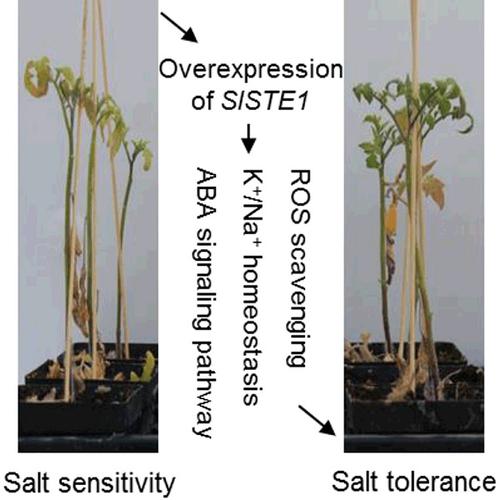当前位置:
X-MOL 学术
›
J. Integr. Plant Biol.
›
论文详情
Our official English website, www.x-mol.net, welcomes your feedback! (Note: you will need to create a separate account there.)
SlSTE1 promotes abscisic acid-dependent salt stress-responsive pathways via improving ion homeostasis and reactive oxygen species scavenging in tomato.
Journal of Integrative Plant Biology ( IF 11.4 ) Pub Date : 2020-07-03 , DOI: 10.1111/jipb.12987 Xiaoqing Meng 1, 2 , Jing Cai 1, 2 , Lei Deng 3 , Ge Li 1, 2 , Jian Sun 1, 2 , Yonghua Han 1, 2 , Tingting Dong 1, 2 , Yang Liu 1, 2 , Tao Xu 1, 2 , Siyuan Liu 1, 2 , Zongyun Li 1, 2 , Mingku Zhu 1, 2
Journal of Integrative Plant Biology ( IF 11.4 ) Pub Date : 2020-07-03 , DOI: 10.1111/jipb.12987 Xiaoqing Meng 1, 2 , Jing Cai 1, 2 , Lei Deng 3 , Ge Li 1, 2 , Jian Sun 1, 2 , Yonghua Han 1, 2 , Tingting Dong 1, 2 , Yang Liu 1, 2 , Tao Xu 1, 2 , Siyuan Liu 1, 2 , Zongyun Li 1, 2 , Mingku Zhu 1, 2
Affiliation

|
High salinity is one of the major limiting factors that reduces crop productivity and quality. Herein, we report that small SALT TOLERANCE ENHANCER1 (STE1) protein without any known conserved domains is required for tomato salt tolerance. Overexpression (OE) of SlSTE1 enhanced the tolerance to multiple chloride salts (NaCl, KCl, and LiCl) and oxidative stress, along with elevated antioxidant enzyme activities, increased abscisic acid (ABA) and chlorophyll contents, and reduced malondialdehyde (MDA) and reactive oxygen species (ROS) accumulations compared to that of wild‐type (WT) plants. Moreover, decreased K+ efflux and increased H+ efflux were detected in the OE plants, which induced a higher K+/Na+ ratio. In contrast, SlSTE1‐RNAi plants displayed decreased tolerance to salt stress. RNA‐seq data revealed 1 330 differentially expressed genes in the OE plants versus WT plants under salt stress, and the transcription of numerous and diverse genes encoding transcription factors, stress‐related proteins, secondary metabolisms, kinases, and hormone synthesis/signaling‐related proteins (notably ABA and 1‐aminocyclopropane‐1‐carboxylate) was greatly elevated. Furthermore, SlSTE1‐OE plants showed increased sensitivity to ABA, and the results suggest that SlSTE1 promotes ABA‐dependent salt stress‐responsive pathways by interacting with SlPYLs and SlSnRK2s. Collectively, our findings reveal that the small SlSTE1 protein confers salt tolerance via ABA signaling and ROS scavenging and improves ion homeostasis in tomato.
中文翻译:

SlSTE1通过改善番茄中的离子稳态和清除活性氧来促进脱落酸依赖性盐胁迫响应途径。
高盐度是降低作物生产力和质量的主要限制因素之一。在本文中,我们报道了番茄盐耐性需要小的无盐保守性增强蛋白(STE1)蛋白而没有任何已知的保守结构域。SlSTE1的过表达(OE)增强了对多种氯化物盐(NaCl,KCl和LiCl)的耐受性和氧化应激,同时增强了抗氧化酶活性,增加了脱落酸(ABA)和叶绿素含量,并降低了丙二醛(MDA)和反应性与野生型(WT)植物相比,氧气(ROS)的积累量更高。此外,降低的ķ +流出并增加ħ +外排在OE植物中检测到,从而诱发较高ķ + /钠+比。相反,SlSTE1-RNAi植物对盐胁迫的耐受性降低。RNA-seq数据揭示了盐胁迫下OE植物与WT植物中1 330个差异表达的基因,以及编码转录因子,胁迫相关蛋白,次级代谢,激酶和激素合成/信号传导相关的众多基因的转录蛋白质(尤其是ABA和1-氨基环丙烷-1-羧酸盐)大大升高。此外,SlSTE1‐OE植物对ABA的敏感性增强,结果表明SlSTE1通过与SlPYL和SlSnRK2相互作用而促进了ABA依赖性盐胁迫响应途径。总的来说,我们的发现表明,小的SlSTE1蛋白通过ABA信号传导和ROS清除赋予盐耐性,并改善了番茄的离子稳态。
更新日期:2020-07-03
中文翻译:

SlSTE1通过改善番茄中的离子稳态和清除活性氧来促进脱落酸依赖性盐胁迫响应途径。
高盐度是降低作物生产力和质量的主要限制因素之一。在本文中,我们报道了番茄盐耐性需要小的无盐保守性增强蛋白(STE1)蛋白而没有任何已知的保守结构域。SlSTE1的过表达(OE)增强了对多种氯化物盐(NaCl,KCl和LiCl)的耐受性和氧化应激,同时增强了抗氧化酶活性,增加了脱落酸(ABA)和叶绿素含量,并降低了丙二醛(MDA)和反应性与野生型(WT)植物相比,氧气(ROS)的积累量更高。此外,降低的ķ +流出并增加ħ +外排在OE植物中检测到,从而诱发较高ķ + /钠+比。相反,SlSTE1-RNAi植物对盐胁迫的耐受性降低。RNA-seq数据揭示了盐胁迫下OE植物与WT植物中1 330个差异表达的基因,以及编码转录因子,胁迫相关蛋白,次级代谢,激酶和激素合成/信号传导相关的众多基因的转录蛋白质(尤其是ABA和1-氨基环丙烷-1-羧酸盐)大大升高。此外,SlSTE1‐OE植物对ABA的敏感性增强,结果表明SlSTE1通过与SlPYL和SlSnRK2相互作用而促进了ABA依赖性盐胁迫响应途径。总的来说,我们的发现表明,小的SlSTE1蛋白通过ABA信号传导和ROS清除赋予盐耐性,并改善了番茄的离子稳态。


























 京公网安备 11010802027423号
京公网安备 11010802027423号